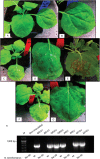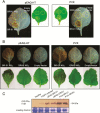The Tomato spotted wilt virus cell-to-cell movement protein (NSM ) triggers a hypersensitive response in Sw-5-containing resistant tomato lines and in Nicotiana benthamiana transformed with the functional Sw-5b resistance gene copy
- PMID: 24720811
- PMCID: PMC6638845
- DOI: 10.1111/mpp.12144
The Tomato spotted wilt virus cell-to-cell movement protein (NSM ) triggers a hypersensitive response in Sw-5-containing resistant tomato lines and in Nicotiana benthamiana transformed with the functional Sw-5b resistance gene copy
Abstract
Although the Sw-5 gene cluster has been cloned, and Sw-5b has been identified as the functional gene copy that confers resistance to Tomato spotted wilt virus (TSWV), its avirulence (Avr) determinant has not been identified to date. Nicotiana tabacum 'SR1' plants transformed with a copy of the Sw-5b gene are immune without producing a clear visual response on challenge with TSWV, whereas it is shown here that N. benthamiana transformed with Sw-5b gives a rapid and conspicuous hypersensitive response (HR). Using these plants, from all structural and non-structural TSWV proteins tested, the TSWV cell-to-cell movement protein (NSM ) was confirmed as the Avr determinant using a Potato virus X (PVX) replicon or a non-replicative pEAQ-HT expression vector system. HR was induced in Sw-5b-transgenic N. benthamiana as well as in resistant near-isogenic tomato lines after agroinfiltration with a functional cell-to-cell movement protein (NSM ) from a resistance-inducing (RI) TSWV strain (BR-01), but not with NSM from a Sw-5 resistance-breaking (RB) strain (GRAU). This is the first biological demonstration that Sw-5-mediated resistance is triggered by the TSWV NSM cell-to-cell movement protein.
Keywords: NSM; Sw-5; TSWV; avirulence; cell-to-cell movement; resistance gene; tospovirus.
© 2014 BSPP AND JOHN WILEY & SONS LTD.
Figures




References
-
- Aramburu, J. and Marti, M. (2003) The occurrence in north‐east Spain of a variant of Tomato spotted wilt virus (TSWV) that breaks resistance in tomato (Lycopersicon esculentum) containing the Sw‐5 gene. Plant Pathol. 52, 407.
-
- Aramburu, J. , Galipienso, L. , Soler, S. and López, C. (2011) Characterization of Tomato spotted wilt virus isolates that overcome the Sw‐5 resistance gene in tomato and fitness assays. Phytopathol. Mediterr. 49, 342–351.
-
- de Ávila, A.C. , De Haan, P. , Smeets, M.L.L. , de Resende, R.O. , Kormelink, R. , Kitajima, E.W. , Goldbach, R.W. and Peters, D. (1993) Distinct levels of relationships between tospovirus isolates. Archives of Virology, 128, 211–227. - PubMed
-
- de Avila, A.C. , Huguenot, C. , Resende, R.O. , Kitajima, E.W. , Goldbach, R.W. and Peters, D. (1990) Serological differentiation of 20 isolates of Tomato spotted wilt virus. Journal of General Virology, 71: 2801–2807. - PubMed
Publication types
MeSH terms
Substances
Associated data
- Actions
- Actions
- Actions
- Actions
- Actions
- Actions
LinkOut - more resources
Full Text Sources
Other Literature Sources

